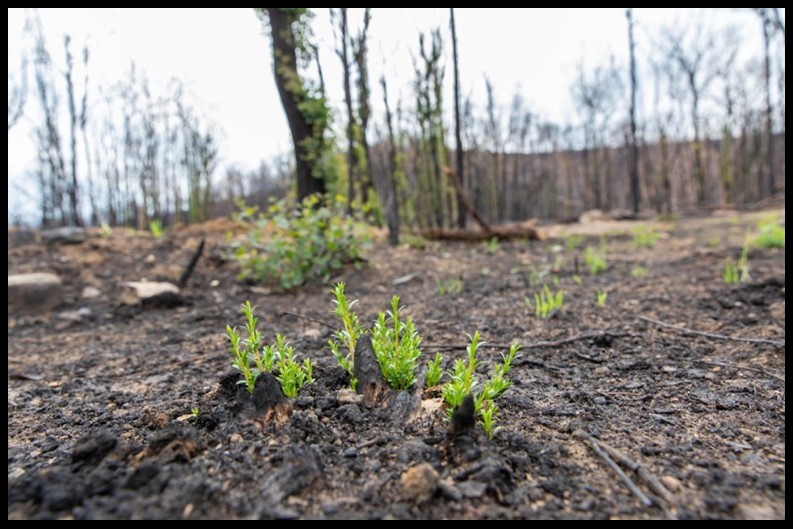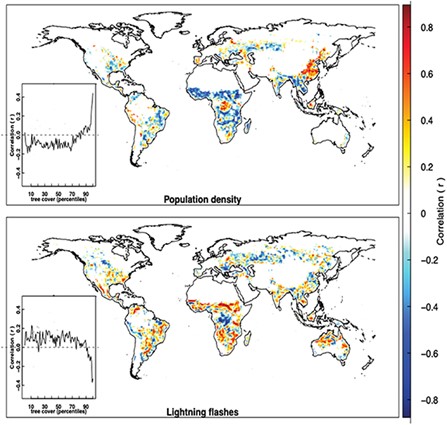Natalie Sanders writes:
How do we disentangle extreme fire events resulting from climate change with natural wildfire regimes? And how might we model the interaction of climate and ecosystem properties, in order to better predict and manage wildfires?

Figure 1. Forest regrowth after wildfire. Victoria, Australia.
Credit Neal Herbert, https://www.usgs.gov/media/images/forest-regrowth-after-a-wildfire.
Part of the answer lies in developing an ecosystem-centred framework, bringing together recent advances in fire knowledge from different perspectives. This idea is the basis of a ‘special issue article’ published in Environmental Research Letters, led by Professor Sandy Harrison at Reading University.
The paper “Understanding and Modelling wildfire regimes: an ecological perspective” is the outcome of a collaboration among several partners, including the LEMONTREE and REALM* projects and the Leverhulme Centre for Wildfires, Environment and Society **.
(https://iopscience.iop.org/article/10.1088/1748-9326/ac39be)
If you’ve seen the news in the last few summers, you will likely have the impression that our planet is on fire. Images pour in on social media and the news of uncontrollable wildfires raging across huge areas, towns left devastated, vast swathes of land left blackened and for the humans and wildlife lucky enough to escape, now left without their homes. They are truly harrowing scenes, and a wildfire is nothing to be dismissive of. However, it’s easy to come away with the view that wildfires are a threat to ecosystems and biodiversity and that they are exclusively due to human-induced climate change and our warming planet. It’s no wonder that we have such a negative perception of wildfires.
But this is only half the picture.
Fire is part of the natural world. Plants and wildfires have co-evolved over a very long geological history and many of our ecosystems and species today actually depend on wildfires for their persistence. Wildfires, whilst in some areas are becoming more frequent, are decreasing in others; and the severity of the fires is not universal. Indeed, research shows that wildfires in many regions of the world at various times, even in recent history, have been much more extensive than they are today.
However, the impacts of present-day wildfires on humans are becoming more of a problem as we increasingly populate regions that are highly susceptible to fire, and becoming even more so due to climate change.
What we don’t have a clear grasp of is the present fire regimes and the fire-vegetation interactions, whether in remote, near-natural ecosystems or in densely settled and managed landscapes. The latter is what the media focuses on.
Research into wildfires is a hot topic, pun intended, and there have been huge advances in many aspects of the ecology of fire – including an understanding of specific plant traits that have evolved as adaptions to fire. However, most of this knowledge has yet to be incorporated into global, process-based fire-enabled vegetation models, like those contributing to the Fire Modeling Intercomparison Project (FireMIP). There is wide variation among models in their predictions of aspects such as fire season length, interannual variability and responses to climate. Some of this variation may be due to a basic conceptual problem – that these models treat fire starts and fire spread as universal, physical processes, without considering (equally universal) plant and ecosystem properties that influence them.
The Fire Framework
This new study outlines an ecosystem-centred framework to synthesize research in fire ecology that will facilitate an improved understanding of the causes and consequences of wildfire in a global context.
- Fire as a natural ecosystem process
There’s no one size fits all when it comes to the natural time interval between fires. In some tropical grasslands fires occur every couple of years, whereas in boreal forest, the interval can be several hundred years. In a hypothetical world without fire, we would likely see an expansion of tropical forests into savannas. We can detect fire intervals using tree-ring data or sedimentary charcoal for historical events, and remotely sensed data to detect burnt area in recent decades. However, remotely sensed data are only available under our current climate, and subject to contemporary patterns of human habitation and land management. Remotely sensed data simply are not sufficient to define what ‘natural’ fire regimes would be like.
- Adaptive traits
Plants and fire have co-evolved with traits varying according to the mode of fire spread or the interval of fire return, for example:
| Fire free areas | No adaptive traits, leaving plants vulnerable to fires if they occur.
|
| Infrequent fires (> 25 year return time) | Resilience: traits such as serotiny, which causes seeds to be released only when fires pass through. |
| Frequent fires (5 – 25 year return time) | Resistance: traits such as thick bark, protected meristems, underground storage organs, resprouting from the base, and umbrella-type canopies. |
| Very frequent fires (< 5 year return time) | Plants with underground meristems and predominantly below-ground biomass, ephemeral plants with fire-promoted germination, and occasional trees with thick bark can survive and thrive despite the fires. |
Plant adaptations to wildfire tend to reinforce the fire regime they are associated with through positive feedback mechanisms. For example, the ability to resprout has a significant positive impact on the speed of ecosystem recovery after fire, and therefore on how well the ecosystem might respond to a climate-induced increase in fire frequency. But resprouting has not usually been included as a trait in models.
- Fragmentation
Fragmenting a habitat can either increase or decrease the risk of wildfires, depending on whether the area is naturally fire-free or fire-prone. If the area is naturally fire-free, breaking the habitat up by logging or deforestation can increase the changes of a fire catching, whether the spark comes from from lightning or human activities. But in areas that are fire-prone, breaking the area up can help to create barriers that will slow or stop the fires. Globally, wildfire frequency has declined since the late nineteenth century due to landscape fragmentation resulting from intensive agriculture, commercial forestry and forest management. In consequence, there is almost no place on Earth now that can be said to have an entirely natural fire regime.
- Ignition sources
Wildfires can be ignited by lightning or, in various ways, by human activities. But research shows that there is no simple relationship at all between variables that represent ignition sources (lightning strikes, human population) and burnt area:
| Lightning | correlates positively with burnt area, i.e., the more lightning events there are, the greater the burnt area…
…but only in regions that are already fire-prone. |
| Human population | correlates positively with burnt area, i.e., the larger the population the greater the burnt area…
...but only if the area is densely forested. More generally, on a global scale, the overriding effect of population on fire is to reduce burnt area, by creating barriers to spread. |
Many current models assume there is a correlation between fire starts and potential ignition sources, but this is not generally the case. Models would be improved if their focus shifted away from ignition sources, towards the potential for fire spread (i.e. the fuel load and flammability of ecosystems) and how this can be modified by human intervention.

Figure 2: Mapped correlations between a) annual burnt area and human population and b) between annual burnt area and cloud-to-ground lightning frequency.
AN ECOSYSTEM-CENTRED FRAMEWORK
The big problem with current fire models is that they do not distinguish different types of fire regime that will react differently to climate change and will require different management strategies. It’s time to embed advances in fire ecology into process-based fire models. This will enable us to more accurately predict how fire regimes might change with climate change, and how best to manage them to safeguard habitation whilst also conserving biodiversity.
Paper reference:
Harrison, S.P., Prentice, I.C., Bloomfield, K.J., Dong, N., Forkel, M., Forrest, M., Ningthoujam, R.K., Pellegrini, A., Shen, Y., Baudena, M., Cardoo, A.W., Huss, J.C., Joshi, J., Oliveras, I., Pausas, J.G. and Simpson, K.J. (2021). Understanding and modelling wildfire regimes: an ecological perspective. Environmental Research Letters, 16, 125008, doi.org/10.1088/1748-9326/ac39be
You can read more about the work being conducted by these linked projects here:
- *REALM https://prenticeclimategroup.wordpress.com/realm-team/, Twitter: @LabPrentice
- **Leverhulme Centre for Wildfires, Environment and Society https://centreforwildfires.org/, Twitter @centrewildfires
